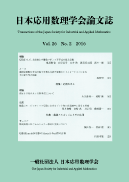Volume 19, Issue 2
Displaying 1-13 of 13 articles from this issue
- |<
- <
- 1
- >
- >|
-
Article type: Cover
2009Volume 19Issue 2 Pages Cover1-
Published: June 25, 2009
Released on J-STAGE: April 08, 2017
Download PDF (22102K) -
Article type: Cover
2009Volume 19Issue 2 Pages Cover2-
Published: June 25, 2009
Released on J-STAGE: April 08, 2017
Download PDF (22102K) -
Article type: Appendix
2009Volume 19Issue 2 Pages App1-
Published: June 25, 2009
Released on J-STAGE: April 08, 2017
Download PDF (41K) -
Article type: Article
2009Volume 19Issue 2 Pages i-
Published: June 25, 2009
Released on J-STAGE: April 08, 2017
Download PDF (162K) -
Article type: Article
2009Volume 19Issue 2 Pages 143-157
Published: June 25, 2009
Released on J-STAGE: April 08, 2017
Download PDF (1336K) -
Article type: Article
2009Volume 19Issue 2 Pages 159-168
Published: June 25, 2009
Released on J-STAGE: April 08, 2017
Download PDF (857K) -
Article type: Article
2009Volume 19Issue 2 Pages 169-181
Published: June 25, 2009
Released on J-STAGE: April 08, 2017
Download PDF (959K) -
Article type: Article
2009Volume 19Issue 2 Pages 183-203
Published: June 25, 2009
Released on J-STAGE: April 08, 2017
Download PDF (1070K) -
Article type: Appendix
2009Volume 19Issue 2 Pages App2-
Published: June 25, 2009
Released on J-STAGE: April 08, 2017
Download PDF (74K) -
Article type: Appendix
2009Volume 19Issue 2 Pages App3-
Published: June 25, 2009
Released on J-STAGE: April 08, 2017
Download PDF (74K) -
Article type: Appendix
2009Volume 19Issue 2 Pages App4-
Published: June 25, 2009
Released on J-STAGE: April 08, 2017
Download PDF (74K) -
Article type: Cover
2009Volume 19Issue 2 Pages Cover3-
Published: June 25, 2009
Released on J-STAGE: April 08, 2017
Download PDF (420K) -
Article type: Cover
2009Volume 19Issue 2 Pages Cover4-
Published: June 25, 2009
Released on J-STAGE: April 08, 2017
Download PDF (420K)
- |<
- <
- 1
- >
- >|
